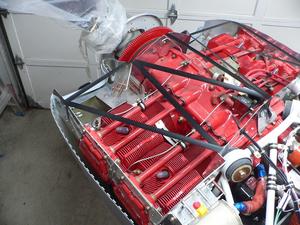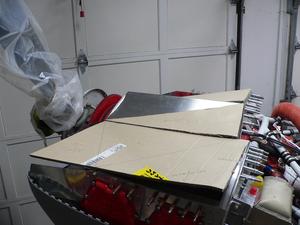I've got a very long list of little items to do, but the biggest single job left is to fabricate a plenum chamber cover for the engine cooling air.
The cooling air comes in the two air inlets, and is trapped by the vertical baffle pieces and the top of the cowling. The only way out is to go between the cylinder fins, or through the oil cooler. The vast majority of builders use rubber baffle seals to seal from the aluminum baffles to the top of the cowling. However, a fair bit of air escapes between the baffle seals and the top of the cowling. People who race aircraft often fabricate a solid plenum cover to go on top of the baffles. The fact that the plenum cover is sealed to the top of the vertical baffles means there is much less air leakage. This means that the air inlets can be smaller, and results in less drag.
I didn't originally plan to use a plenum chamber top, but the way I trimmed the cowling resulted in not a lot of clearance between the tops of the baffles and the cowling. It didn't look like there was enough room to fit rubber baffle seals. And, I had trimmed the cowling inlets to a smaller size than is used by most builders, so I need to be sure that all the air that comes in is used for cooling.
My initial plan was to make the plenum chamber top from fibreglas, but I got scared off by the high temperatures. I read about a Lancair owner with a plenum chamber who measured temperatures of over 250°F after shutdown, as the hot engine radiated its heat to the surroundings. The West Systems epoxy that I have been using has a glass transition temperature (Tg) of about 140°F. The glass transition temperature is the temperature at which the epoxy resin starts to transition from a hard glass-like state to a softer rubber-like state. Obviously I couldn't use West Systems epoxy for this job. I looked into other epoxies with higher Tgs, but they required curing at high temperatures to achieve the high Tg - not really practical. So, fibreglas was out, and aluminum was in.
 I started planning the details of the aluminum plenum chamber a week or so ago. Looking at the shape of the top, there was no way to do it in a single sheet of aluminum, as I can't do compound curves. I took some electrical tape to mark off a series of triangles. Each triangle marks an area that will be in a single plane, with a bend, or a riveted seam between triangles. There will be one area at the back on each side that will get a curve in one axis.
I started planning the details of the aluminum plenum chamber a week or so ago. Looking at the shape of the top, there was no way to do it in a single sheet of aluminum, as I can't do compound curves. I took some electrical tape to mark off a series of triangles. Each triangle marks an area that will be in a single plane, with a bend, or a riveted seam between triangles. There will be one area at the back on each side that will get a curve in one axis.
Earlier this week I fabricated flanges to rivet to the tops of the vertical baffles. The plenum chamber top will the screwed to nut plates in the flanges.
 Today I started to fabricate the actual plenum chamber top. I started off by making cardboard patterns, to be sure to have the shapes right before I cut aluminum. The first piece of aluminum fit perfectly, and I got most of the rest of cardboard patterns made. This was going much, much better than I expected. I caught myself thinking how smoothly it was going, and then remembered all the other times I have thought the same thing. Usually a thought of how well things are going is the prelude to some disaster. Either I only think it is going well because I have overlooked some important complication, or I get complacent because it is going smoothly and then make a huge mistake. I decided to stop for the day before it all fell apart. I'll take a very careful look at the whole situation tomorrow, to be sure it really is going as nicely as it seems.
Today I started to fabricate the actual plenum chamber top. I started off by making cardboard patterns, to be sure to have the shapes right before I cut aluminum. The first piece of aluminum fit perfectly, and I got most of the rest of cardboard patterns made. This was going much, much better than I expected. I caught myself thinking how smoothly it was going, and then remembered all the other times I have thought the same thing. Usually a thought of how well things are going is the prelude to some disaster. Either I only think it is going well because I have overlooked some important complication, or I get complacent because it is going smoothly and then make a huge mistake. I decided to stop for the day before it all fell apart. I'll take a very careful look at the whole situation tomorrow, to be sure it really is going as nicely as it seems.